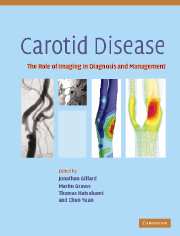Book contents
- Frontmatter
- Contents
- List of contributors
- List of abbreviations
- Introduction
- Background
- 1 Pathology of carotid artery atherosclerotic disease
- 2 Epidemiology of carotid artery atherosclerosis
- 3 Genetics of carotid atherosclerosis
- 4 Hematological processes in emboli formation
- 5 Medical treatment for carotid stenosis
- 6 Surgical management of symptomatic carotid disease: carotid endarterectomy and extracranial-intracranial bypass
- 7 Surgery for asymptomatic carotid stenosis
- 8 Interventional management of carotid disease
- Luminal imaging techniques
- Morphological plaque imaging
- Functional plaque imaging
- Plaque modelling
- Monitoring the local and distal effects of carotid interventions
- Monitoring pharmaceutical interventions
- Future directions in carotid plaque imaging
- Index
- References
6 - Surgical management of symptomatic carotid disease: carotid endarterectomy and extracranial-intracranial bypass
from Background
Published online by Cambridge University Press: 03 December 2009
- Frontmatter
- Contents
- List of contributors
- List of abbreviations
- Introduction
- Background
- 1 Pathology of carotid artery atherosclerotic disease
- 2 Epidemiology of carotid artery atherosclerosis
- 3 Genetics of carotid atherosclerosis
- 4 Hematological processes in emboli formation
- 5 Medical treatment for carotid stenosis
- 6 Surgical management of symptomatic carotid disease: carotid endarterectomy and extracranial-intracranial bypass
- 7 Surgery for asymptomatic carotid stenosis
- 8 Interventional management of carotid disease
- Luminal imaging techniques
- Morphological plaque imaging
- Functional plaque imaging
- Plaque modelling
- Monitoring the local and distal effects of carotid interventions
- Monitoring pharmaceutical interventions
- Future directions in carotid plaque imaging
- Index
- References
Summary
Introduction
Stroke is a major health care problem in the United States, representing the third leading cause of death and the primary cause of disability (Mayberg, 1996). It is estimated that 700 000 people suffer a stroke in the United States annually resulting in approximately 53.6 billion dollars in direct and indirect costs (Hanel et al., 2005). These numbers are expected to increase with an aging population.
Symptomatic carotid stenosis or occlusion is, by some estimates, responsible for 25% of all ischemic stroke (Hanel et al., 2005) with an estimated 6–7% estimated annual stroke rate for patients with both symptomatic carotid stenosis or completed occlusion (Mayberg, 1996; Grubb and Powers, 2001). Sufficient evidence is now available from several clinical trials (MRC European Carotid Surgery Trial, 1991; Mayberg et al., 1991; Barnett et al., 1998) showing that carotid endarterectomy can reduce the risk of stroke for symptomatic carotid stenosis. More recent evidence (Yadav et al., 2004) has shown that in certain subgroups of patients (high risk for carotid endarterectomy), carotid angioplasty and stenting may be an equally safe and effective treatment. This chapter will review the major clinical trials on carotid endarterectomy and carotid angioplasty and stenting and summarize the technique used by the authors for carotid endarterectomy. A brief review of the role for carotid angioplasty and stenting will shed light on the future that carotid endarterectomy may play in a rapidly changing environment.
Keywords
- Type
- Chapter
- Information
- Carotid DiseaseThe Role of Imaging in Diagnosis and Management, pp. 72 - 85Publisher: Cambridge University PressPrint publication year: 2006



